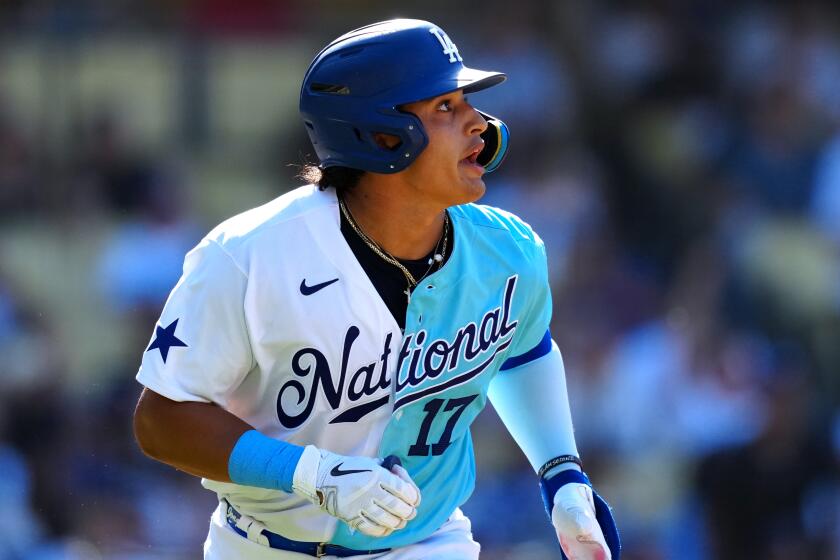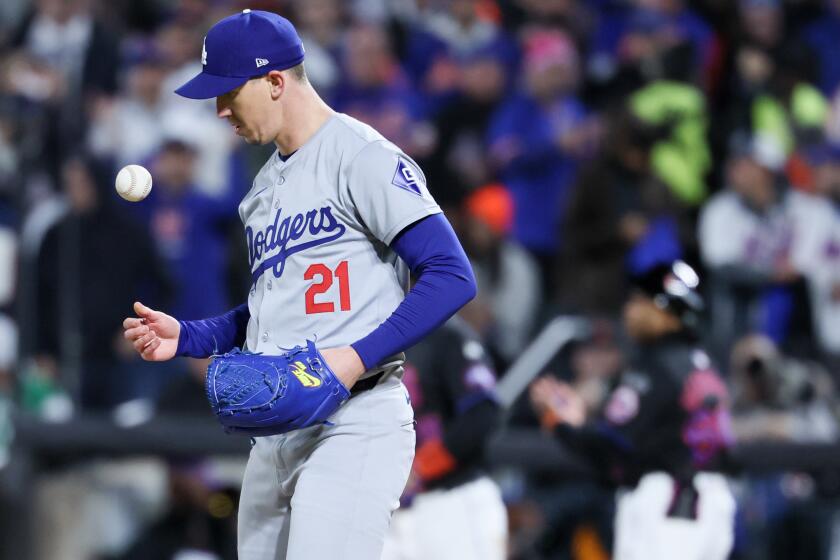Bonds Ends on Upswing
Balancing on those infamously balmed and flaxseed-oiled knees, Barry Bonds in 2006 limped and wobbled and shuffled, and gathered enough momentum to stay a stride ahead of what pursued him, that being retirement, arthritis, bone chips, outer-half sliders, investigative reporters, public ridicule, federal prosecutors and grand juries.
As he did, he hit 26 more home runs, passing Babe Ruth on a Sunday afternoon in May, turning 42 on a Monday in July, drawing to within 21 home runs of Hank Aaron on a Saturday in September.
By the grace of Felipe Alou and endless ice bags, he avoided the disabled list, despite warning-track symptoms (three home runs in April, four in May, four in June, three in July) and heavy-bat indicators (.277 batting average in April, .239 in May, .229 in June, .222 in July) that suggested not only a problem, but a serious one.
But here stands Bonds, who is expected to play two of the three games against the Dodgers at AT&T; Park this weekend, apparently resolute on continuing his baseball career, either with the San Francisco Giants or against them.
His agent, Jeff Borris, said this week that Bonds was an absolute for next season, meaning another extended Bonds Watch, and probably allowing the Bay Area to resurrect the sound of one fan base clapping.
Commissioner Bud Selig and his lieutenants almost certainly would prefer that Bonds go away, leaving one less reminder of the game’s steroid era and everyone’s culpability in it, and leaving the home run record to Aaron.
Even the Giants, perhaps, assumed the hobbled Bonds was closer to playing himself out of the league than back into it.
On Aug. 20, Bonds was batting .235, had homered twice in a month, and still wasn’t covering much ground in left field. Bonds was talking about going home and taking up the possibility of retirement with his family, and a National League scout who saw him at the time said Bonds’ game appeared to be deteriorating.
“He was a very old man trying to play left field,” the scout said. “I think he’s an American League player now. Physically, he can’t withstand playing in the field. I don’t know if it’s his knees or his age. It’s probably both. But he can’t run.”
Offensively, the scout said, “he was hitting ground balls through the [defensive] shift, and that’s all. And everybody is pitching to him this year, basically. Pitchers are trying to make him inside-conscious as much as possible, even with average fastballs, then get him out away. There’s not that fear of his hitting like there used to be.”
Just a week ago, however, an American League scout watched Bonds for several days and came away with an entirely different opinion. Though playing through bone chips in his left elbow that will require surgery shortly after the regular season, Bonds swung the bat better, roamed left field better, and appeared to the scout to have retaken some of his previous athletic ability.
“It was the best I’d seen him play all year,” the second scout said. “He was moving better. He had his lateral movement back. Before, he couldn’t go left and right. He could only go forward and then he couldn’t stop. Now, he’s getting to balls and he’s swinging the bat better.”
Those are the images Bonds, who made $18 million this season, will take into negotiations with the Giants first. If those discussions are not fruitful, then Bonds will file for free agency shortly after the World Series, and 29 other general managers will have the opportunity to bid on Bonds, his conditions, his handlers, his march on Aaron and a hovering federal investigation.
The Giants have competitive and financial incentives to preserve the relationship, given many of their most productive and recognizable players -- Jason Schmidt, Ray Durham, Pedro Feliz, Moises Alou, Shea Hillenbrand and Steve Finley among them -- also can be free agents.
Manager Felipe Alou respects Bonds and tolerated the distractions that came with him, but he is expected to retire from the bench and become a consultant to General Manager Brian Sabean. That means a new clubhouse leader and further changes to an organization in transition, affixing another variable to Bonds’ decision to continue playing.
In all, the aging Giants, built for Bonds’ final seasons but eliminated from postseason participation Monday, can have as many as 11 free agents, including their three through seven hitters.
With the All-Star game coming to San Francisco, a ballpark to pay off and a sudden upturn in his production, Bonds going on 43 could be far different than Bonds at 42. After all, Alou told reporters in San Francisco, he’ll have five months off his knees.
“He’ll probably be a lot better,” he said.
*
(BEGIN TEXT OF INFOBOX)
Down to the wire
From the East Coast to the West, the Dodgers and Giants have a history of knocking each other out of postseason contention on the last weekend of the season. A look at some of the most prominent examples:
1951
With a 13-game lead on Aug. 15, Brooklyn seems a lock to win the pennant. But the Giants storm back and tie the Dodgers, forcing a three-game playoff to determine the National League champion. After splitting the first two games, the Dodgers take a 4-1 lead into the ninth inning of Game 3. After Whitey Lockman’s double makes it 4-2, Bobby Thomson steps to the plate with two runners on base. The Dodgers counter with Ralph Branca. Two pitches later, perhaps the most famous home run in baseball history puts the Giants in the World Series.
1962
The Dodgers have a two-game lead over the Giants with three to play but are swept by the Cardinals in the final three games while the Giants win two of three from Houston, forcing a three-game playoff. After splitting the first two games, the Dodgers take a 4-2 lead into the ninth inning of Game 3. Pitcher Ed Roebuck gives up a single and two walks, loading the bases with one out for Willie Mays, who singles to make the score 4-3. Stan Williams replaces Roebuck and gives up a tying sacrifice fly to Orlando Cepeda. After Ed Bailey is walked intentionally to load the bases, Williams walks Jim Davenport to score the go-ahead run. An error by second baseman Larry Burright brings in the fourth run of the inning, and the Giants win, 6-4, on two singles, four walks, and error and a sacrifice fly.
1982
The Dodgers are one game behind Atlanta on the final day of the season. Knowing the Braves have already lost, L.A. needs to beat the Giants to force a playoff with the Braves. With the score tied, 2-2, in the bottom of the seventh at Candlestick Park, reliever Tom Niedenfuer gives up a single to Bob Brenly and a double to Champ Summers before being replaced by Terry Forster with one out and runners on second and third. Forster strikes out pinch-hitter Jim Wohlford, but Joe Morgan hits a three-run homer down the right-field line and the Giants hold on to win, 5-3.
1991
The Dodgers are tied with Atlanta with the final three games of the season to be played at Candlestick Park. Jack Clark homers on Friday night in a 4-1 Giants victory, putting the Dodgers one game behind Atlanta. On Saturday, needing a win to remain in contention, the Dodgers are shut out and eliminated, 4-0, on a two-hitter by Trevor Wilson in his only complete game of the season. After picking up a meaningless win Sunday, L.A. ends the season one game behind Atlanta.
1993
With 103 wins, the Giants go into Dodger Stadium on the final day of the season tied with Atlanta for first place in the NL West. With staff aces Bill Swift and John Burkett not available, Dusty Baker gives the ball to rookie Salomon Torres. The Dodgers turn the game into a laugher, as Mike Piazza homers twice, Cory Snyder and Raul Mondesi homer and Eric Karros has a double and a triple in a 12-1 rout.
-- HOUSTON MITCHELL
More to Read
Are you a true-blue fan?
Get our Dodgers Dugout newsletter for insights, news and much more.
You may occasionally receive promotional content from the Los Angeles Times.







